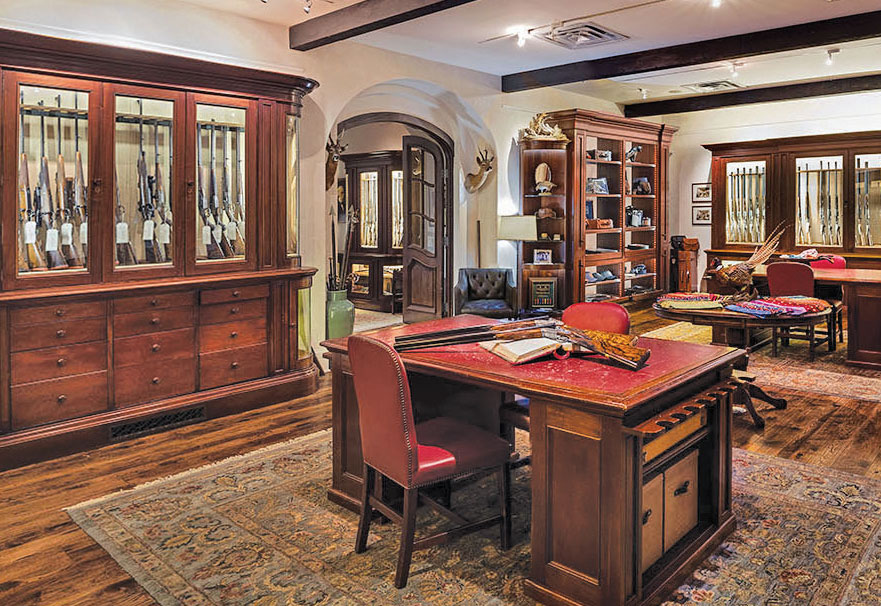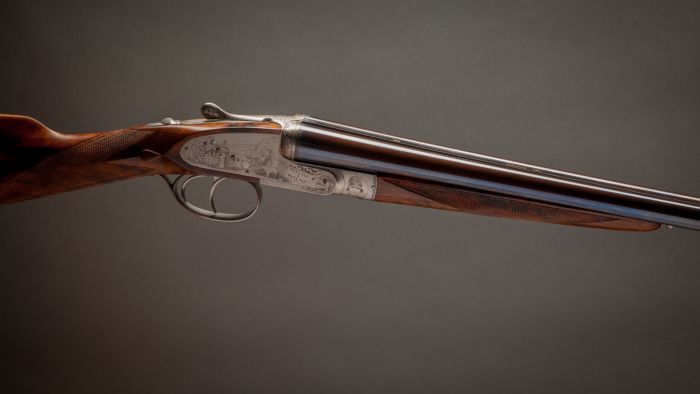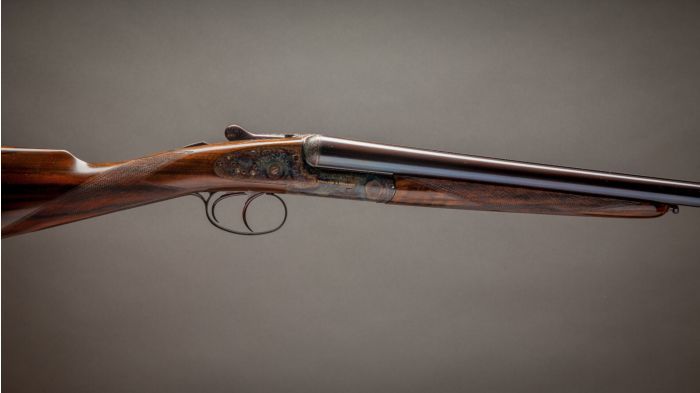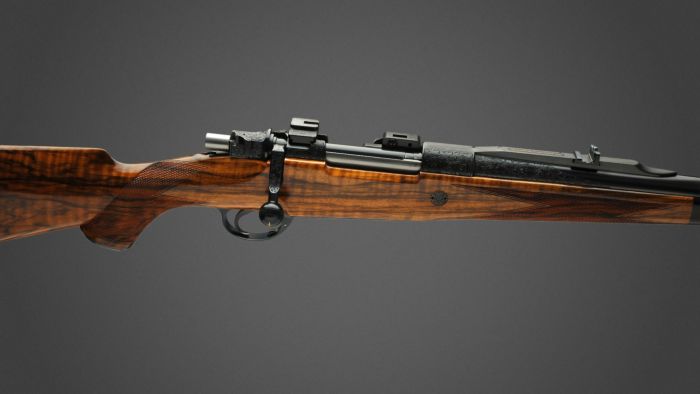A London Gun Room In Dallas
February 5, 2020



 SCA Articles
SCA Articles

While often attributed to Winston Churchill, it was actually George Bernard Shaw who first quipped that, “Britain and America are two nations divided by a common language.” One of the words that might well have prompted this sentiment is the quintessentially English expression, bespoke.
With etymological roots in the Old English word bespeak (which came in the 16th century to mean “to order in advance”), bespoke evolved into an adjective that means something that is specifically and uniquely made from scratch to the requirements and to the fit of an individual customer. Referring to the crème de la crème of handcrafted products, whether Saville Row suit or London “Best” gun, bespoke nonetheless conveys, in a classically understated British fashion, neither pretense nor showiness. It ain’t, as us Yanks might say, a highfalutin word.
Bespoke, however, does exist today in an increasingly rarified atmosphere, an exclusive environment where artistry and craftsmanship come together to create something uniquely, “just for you.” That, of course, is at the heart of the Holland & Holland philosophy: No part of a Holland & Holland gun is interchangeable. Everything is made specifically for one gun—yours—down to the smallest pin. As the firm aptly states, “That is why, at most, just 70 guns are made each year, by the finest, most dedicated and enthusiastic craftsmen in the world—blending the past and the present into every sporting shotgun and rifle.”
The past for Holland & Holland took root with the birth in London of Harris Holland in 1806. While gun makers of that era most always got their start as apprentices in the trade—James Purdey, for example, originally worked as a stocker for the famed English gun firm, Joseph Manton—Harris Holland came into the business from a different direction.
A successful wholesale tobacconist, Harris became an avid and highly accomplished pigeon shot. Time spent in the pigeon ring no doubt prompted Harris to develop his own ideas about the performance and handling characteristics he sought in a shotgun. Not surprisingly, he was having guns built to order in the trade by the 1840s.
By 1850, “H. Holland” was a gun maker and Holland’s winning ways in the pigeon ring, which were well reported in the sporting press, helped create a brand identity that gave the new firm a valuable edge in sales. Looking to expand, the company soon moved from King Street to Bond Street in the fashionable Mayfair district.
Childless, Harris Holland brought in his nephew, Henry Holland, as an apprentice in 1860. Apparently, “born to the business,” young Henry went on to become a highly regarded and gifted inventor who played a key role in building the success of his uncle’s company. He secured the first of the company’s patents in 1861 and was brought in as a partner in 1876, thus creating “Holland & Holland.”
Holland & Holland quickly established itself as one of England’s premier gun makers gaining, in 1883, Royal Warrants from the King of Italy and King George V, among others. In 1885, the name “Royal” was adopted for the firm’s best guns.
In 1898, Holland & Holland completed building its own factory in Kensal Green, west of central London and not far from Paddington Station. It is a tall, slender building—still, almost a 120 years later, in use today—with purposely built large windows for maximum natural light. The firm notes that, on one side, the actioners take advantage of the early morning light while, on the other side, the engravers prefer the afternoon light for their craft.
Never a large company, I have always believed that Holland & Holland, has nonetheless, long punched well above its weight class. Over the years, for example, Holland & Holland has introduced some 20 different rifle calibers including the iconic .375 H&H Magnum in 1912, the .300 H&H Magnum in 1925, and its .700 Nitro Express in 1988. The company has also made groundbreaking innovations in respect to the design of shotguns and rifles.
Developed late in the 19th century, Holland & Holland’s sidelock action, for example, has long been recognized as a worldwide standard for high-grade sidelock guns. Our own Michael McIntosh, writing for the magazine in 2001, noted that, “It is one of the most significant inventions in the history of modern firearms—a cocking system and lockwork that has become the most widely copied pattern ever for a sidelock gun. Its evolution began in 1883, with a patent issued to Henry Holland and John Robertson, a Scottish craftsman who was an outworker to the trade and who later became the owner of Boss & Co. The action itself was fully developed by about 1895, but Henry Holland continued adding refinements such as a single trigger, hand-detachable locks and finally a self-opening system patented in 1922.”

Henry Holland also knew a good thing when he saw it. A career soldier in the British Army, Colonel George Vincent Fosbury, patented in 1885 an unusual but very effective “combination gun,” in essence, a side-by-side shotgun with shallow rifling cut into the last few inches of each barrel. The gun could thus be used as a regular shotgun or accurately fire heavy slugs to deal with large animals that British adventurers might encounter in the far-flung reaches of the Empire, whether the jungles of India or Africa.
Fosbury offered manufacturing rights to Henry Holland who quickly grasped the opportunity, suitably naming this shotgun/rifle hybrid the Paradox. From 1886 to when the patent expired in 1899, Holland & Holland owned exclusive rights to this very popular gun.
Today, the company continues to develop new offerings, such as their Sporting over & under and Round Action shotgun and rifle, while its core tradition as a London “Best” gunmaker is as strong as ever. I recently had the opportunity to spend a day with H&H executive director Guy Davies at the company’s newly opened showroom in Dallas. The obvious first question I asked Guy was, “Why Dallas?”

“When we took a careful look at who was buying our guns, customers from this region of America were at the top of the list. So, we pulled up stakes from New York City and came down here. Also, having a shooting facility such as the Dallas Gun Club nearby is a great advantage in working with customers to evaluate and confirm stock measurements, from the patterning board on to a variety of going away and crossing shots. From every perspective, we’ve been very pleased with the move.”
Not that I had any illusion about actually ordering a “Royal” side-by-side from Guy, but I did ask him what the step-by-step process would involve— just in case my aging Aunt Emma has secretly stashed away millions. “It all starts,” noted Guy, “with a fitting session using one of our “try guns.” Guy then brought out and we reviewed one of Holland & Holland’s Gun Measurement Forms that includes various measurements in categories such as length, bend (what we call drop), and either cast on, or cast off.
Guy told me he keeps a nice selection of blanks at the Dallas showroom and customers can also review photos of the typically 150 blanks available in London. There are blanks matched as a pair should you be ordering a matched pair of ‘Royals’ for next year’s driven bird season. If so, bless your heart. Stocks are available in straight hand or semi-pistol with an optional gold oval engraved with initials, or crest.
The, dare I say, standard, engraving pattern is the company’s traditional “Royal” scroll pattern with either case coloring or a bright finish. Should you wish something else, you may peruse Holland & Holland’s “Engraving Bible” that contains over 50 different patterns. Indeed, the engraving potential is virtually unlimited and various game scenes, precious metal inlays or personal designs can all be incorporated. You may, of course, also choose your own H&H engraver.

The “Royal” is available either as a side-by-side or an over-and-under (and I should note that the “Roya”’ designation also applies to H&H’s famed double barrel rifle) and comes in all standard gauges. Customers may choose from either a single or double trigger or either a manual or automatic safety. Barrels options are from 25” to 32” with game rib and choked to customer preference. While weights vary slightly depending on specifications, a “Royal” 12-gauge comes in at close to six pounds 12 ounces and a 20 gauge about a pound less.
Introduced in 2002, Holland & Holland’s “Round Action” shotgun is a practical alternative to its top-of-the- line “Royal” grade. Available in either 12 or 20 gauge, the “Round Action” shotgun is entirely made in the H&H factory by the same craftsmen who make all the company’s guns. Of note, the “Round Action” guns include a modern version of H&H’s famed Paradox “ball & shot” gun.
Rounding out the Holland & Holland line is its “Bolt Action” magazine rifle, introduced just after the First World War. Built on a modified Mauser ’98 action, the rifle is offered in most modern calibers and with a wide range of custom options. If there is a more classic bolt-action rifle, I don’t know what it is.
Delivery on, for example, a “Royal” side-by-side is a year to 15 months, understandable when you consider that, on average, it takes some 850 man hours to complete a gun. For the hunter pressed for time, Guy made the point that he has on hand in the Dallas showroom a selection of new “stock” guns in a mix of different models, gauges and engraving patterns. These guns have been left with a length-of-pull of more than 15” so they can be cut down to a customer’s measurements and certain adjustments to comb height and cast on/off can also be made. With stock adjustments, these guns can be delivered in about one month.
Whatever you choose, when you first pick up your new Holland & Holland it doesn’t matter a wit whether you say “Giddy Up’” or “Tally Ho,” you can be assured the gun in your hands is the best that best can be.
